CBSE Class 12 Physics Sample Paper 2023
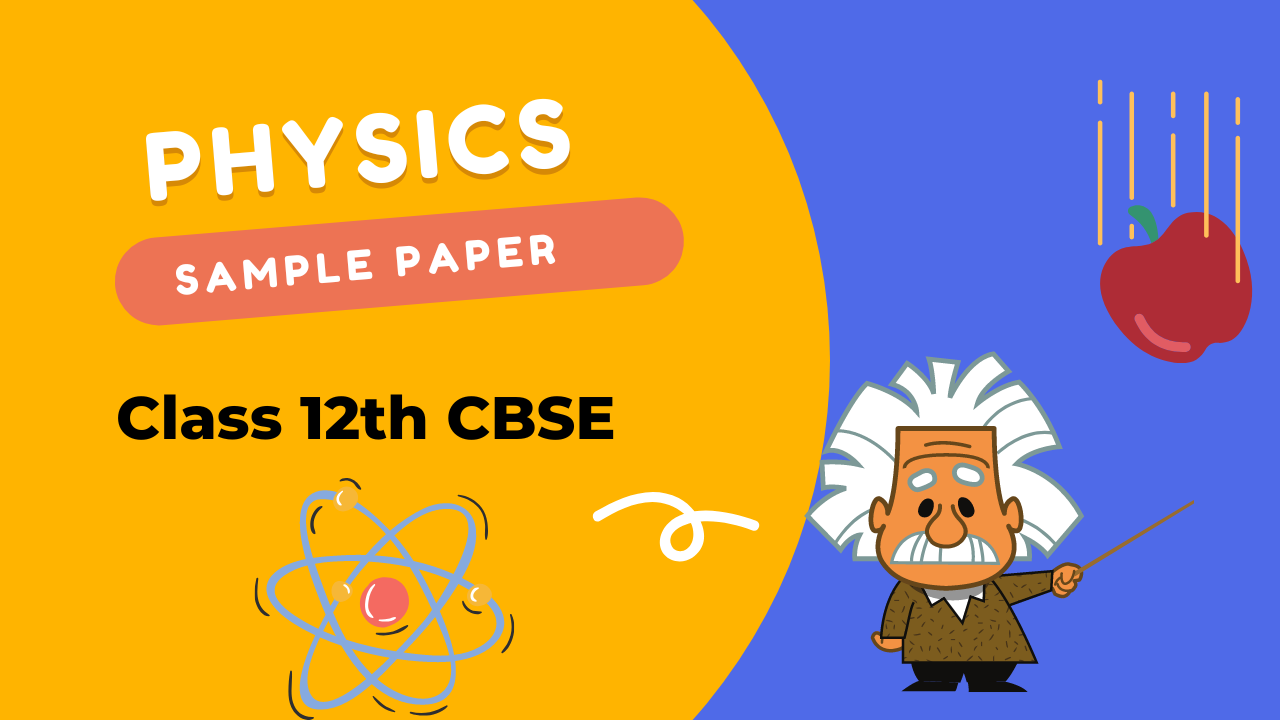
We have covered the CBSE Class 12 Physics Sample Paper 2023. The students must solve CBSE Class 12 Physics Sample Paper which is given on this page and bookmark this page to get all the latest updates from CBSE regarding CBSE Annual Exam.
Solving Sample Papers will help you to know the gist of the examination pattern, the weightage of the questions, and also the type of questions asked in the class 12th board examinations.
We have also covered CBSE Class 12 Physics Sample Paper 2023 pdf along with CBSE Class 12 Physics Sample Paper 2023 Marking Scheme to help the students in every possible manner with accurate solutions.
Class 12 Physics Sample Paper 2023
•Maximum Marks: 70 Marks
•Time Allowed: 3 hours.
General Instructions:
(1) There are 35 questions in all. All questions are compulsory
(2) This question paper has five sections: Section A, Section B, Section C, Section D, and Section E. All the sections are compulsory.
(3) Section A contains eighteen MCQs of 1 mark each, Section B contains seven questions of two marks each, Section C contains five questions of three marks each, Section D contains three long questions of five marks each, and Section E contains two case study based questions of 4 marks each.
(4) There is no overall choice. However, an internal choice has been provided in sections B, C, D, and E. You have to attempt only one of the choices in such questions.
5. Use of calculators is not allowed.
Class 12 Physics Sample Paper 2022-23: SECTION – A
SECTION A (1 mark each)
Q.1.According to Coulomb’s law, which is the correct relation for the following figure?

(i) q1 q2> 0
(ii) q1 q2<0
(iii) q1 q2 =0
(iv) 1> q1/ q2 > 0
Q.2. The electric potential on the axis of an electric dipole at a distance ‘r from its centre is V. Then the potential at a point at the same distance on its equatorial line will be
(i) 2V
(ii) -V
(iii) V/2
(iv) Zero
Q.3 The temperature (T) dependence of resistivity of materials A and material B is represented by fig (i) and fig (ii) respectively. Identify material A and material B.

(i) material A is copper and material B is germanium
(ii) material A is germanium and material B is copper
(iii) material A is nichrome and material B is germanium
(iv) material A is copper and material B is nichrome
Q.4.Two concentric and coplanar circular loops P and Q have their radii in the ratio 2:3. Loop Q carries a current 9 A in the anticlockwise direction. For the magnetic field to be zero at the common center, loop P must carry
(i) 3A in the clockwise direction
(ii) 9A in clockwise direction
(iii) 6 A in anti-clockwise direction
(iv) 6 A in the clockwise direction
Q.5.A long straight wire of circular cross-section of radius a carries a steady current I. The current is uniformly distributed across its cross-section. The ratio of the magnitudes of the magnetic field at a point distant a/2 above the surface of wire to that at a point distanta/2 below its surface is
(i) 4 :1
(ii) 1:1
(iii) 4: 3
(iv) 3 :4
Q.6. If the magnetizing field on a ferromagnetic material is increased, its permeability
(i) decreases
(ii) increases
(iii) remains unchanged
(iv) first decreases and then increases
Q.7. An iron-cored coil is connected in series with an electric bulb with an AC source as shown in the figure. When an iron piece is taken out of the coil, the brightness of the bulb will
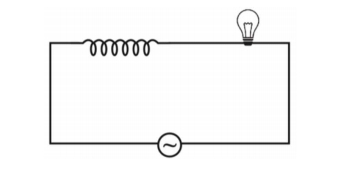
(i) decrease
(ii) increase
(iii) remain unaffected
(iv) fluctuate
Q.8. Which of the following statement is NOT true about the properties of electromagnetic waves?
(I) These waves do not require any material medium for their propagation
(ii) Both electric and magnetic field vectors attain the maxima and minima at the same time
(iii) The energy in an electromagnetic wave is divided equally between electric and magnetic fields
(iv) Both electric and magnetic field vectors are parallel to each other
Q.9. A rectangular, a square, a circular and an elliptical loop, all in the (x-y) plane, are moving out of a uniform magnetic field with a constant velocity 𝑣⃗ = v𝚤̂.The magnetic field is directed along the negative z-axis direction. The induced emf, during the passage of these loops, out of the field region, will not remain constant for
(i) any of the four loops
(ii) the circular and elliptical loops
(iii) the rectangular, circular and elliptical loops
(iv) only the elliptical loops
Q.10. In Young’s double slit experiment, the path difference at a certain point on the screen between two interfering waves is 𝟏/𝟖 th of the wavelength. The ratio of intensity at this point to that at the centre
of a bright fringe is close to
(i) 0.80
(ii) 0.74
(iii) 0.94
(iv) 0.85
Q.11. The work function for a metal surface is 4.14 eV. The threshold wavelength for this metal surface is:
(i) 4125 Å
(ii) 2062.5 Å
(iii) 3000 Å
(iv) 6000 Å
Q.12. The radius of the innermost electron orbit of a hydrogen atom is 5.3×10–11 m. The radius of the n =3 orbit is
(i) 1.01 x 10-10m
(ii) 1.59 X 10-10m
(iii) 2.12 x 10-10m
(iv) 4.77 X 10-10m
Q.Which of the following statements about nuclear forces is not true?
(i) The nuclear force between two nucleons falls rapidly to zero as their distance is more than a few femtometres.
(ii) The nuclear force is much weaker than the Coulomb force.
(iii) The force is attractive for distances larger than 0.8 FM and repulsive if they are separated by distances less than 0.8 FM.
(iv) The nuclear force between neutron-neutron, proton-neutron, and proton-proton is approximately the same.
Q.14 If the reading of the voltmeter V1 is 40 V, then the reading of voltmeter V2 is
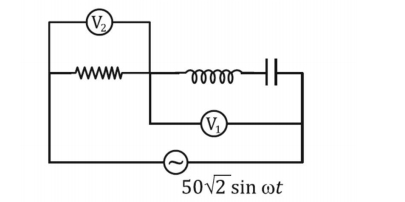
(i) 30 V (ii) 58 V (iii) 29 V (iv) 15 V
Q.15.The electric potential V as a function of distance X is shown in the figure.
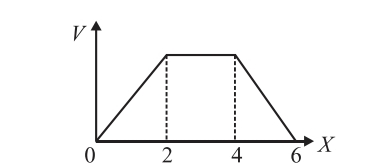
The graph of the magnitude of electric field intensity E as a function of X is
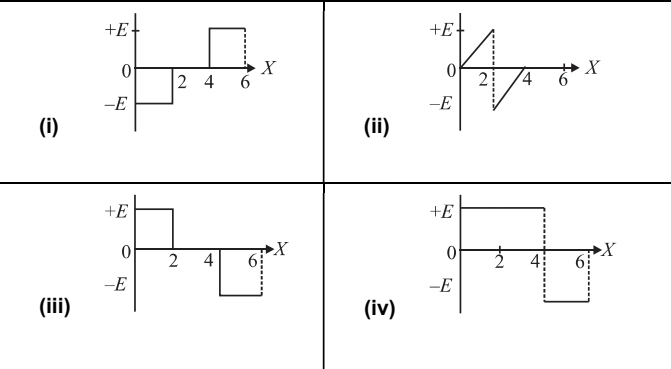
Q. 16 Two statements are given-one labelled Assertion (A) and the other labelled Reason (R). Select the correct answer to these questions from the codes (a), (b), (c) and (d) as given below.
a) Both A and R are true and R is the correct explanation of A
b) Both A and R are true and R is NOT the correct explanation of A
c) A is true but R is false
d) A is false and R is also false
ASSERTION(A): The electrical conductivity of a semiconductor increases on doping.
REASON: Doping always increases the number of electrons in the semiconductor
Q.17. Two statements are given-one labelled Assertion (A) and the other labelled Reason (R). Select the correct answer to these questions from the codes (a), (b), (c) and (d) as given below.
a) Both A and R are true and R is the correct explanation of A
b) Both A and R are true and R is NOT the correct explanation of A
c) A is true but R is false
d) A is false and R is also false
ASSERTION:
In an interference pattern observed in Young’s double slit experiment, if the separation (d) between coherent sources as well as the distance (D) of the screen from the coherent sources both are reduced to 1/3rd, then new fringe width remains the same.
REASON:
Fringe width is proportional to (d/D).
Q.18. Two statements are given-one labeled Assertion (A) and the other labelled Reason (R). Select the correct answer to these questions from the codes (a), (b), (c) and (d) as given below.
a) Both A and R are true and R is the correct explanation of A
b Both A and R are true and R is NOT the correct explanation of A
c) A is true but R is false
d) A is false and R is also false
Assertion(A) :
The photoelectrons produced by a monochromatic light beam incident on a metal surface have a spread in their kinetic energies.
Reason(R) :
The energy of electrons emitted from inside the metal surface, is lost in collision with the other atoms in the metal.
Class 12 Physics Sample Paper 2022-23: SECTION – B
SECTION B (2 marks each)
Q.19. Electromagnetic waves with a wavelength
(i) λ1 is suitable for radar systems used in aircraft navigation.
(ii) λ2 is used to kill germs in water purifiers.
(iii) λ3 is used to improve visibility in runways during fog and mist conditions.
Identify and name the part of the electromagnetic spectrum to which these
radiations belong. Also, arrange these wavelengths in ascending order of their
magnitude.
Q.20. A uniform magnetic field gets modified as shown in the figure when two specimens A and B are placed in it.

(i)Identify the specimen A and B.
(ii) How is the magnetic susceptibility of specimen A different from that of specimen B?
Q.21. What is the nuclear radius of 125Fe ,if that of 27 Al is 3.6 fermi?.
OR
The short wavelength limit for the Lyman series of the hydrogen spectrum is 913.4 A0. Calculate the short wavelength limit for the Balmer series of the hydrogen spectrum.
Q.22.A biconvex lens made of a transparent material of refractive index 1.25 is immersed in water of refractive index 1.33. Will the lens behave as a converging or a diverging lens? Justify your answer.
Q.23. The figure shows a piece of pure semiconductor S in series with a variable resistor R and a source of constant voltage V. Should the value of R be increased or decreased to keep the reading of the ammeter
constant, when semiconductor S is heated? Justify your answer.
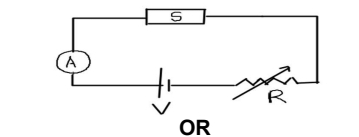
The graph of the potential barrier versus the width of the depletion region for an unbiased diode is shown in graph A. In comparison to A , graphs B and C are obtained after biasing the diode in different ways.Identify the
type of biasing in B and C and justify your answer.

Q.24.A narrow slit is illuminated by a parallel beam of monochromatic light of wavelength λ equal to 6000 Å and the angular width of the central maximum in the resulting diffraction pattern is measured. When the slit
is next illuminated by light of wavelength λ’, the angular width decreases by 30%. Calculate the value of the wavelength λ’.
Q.25.Two large, thin metal plates are parallel and close to each other. On their inner faces, the plates have surface charge densities of opposite signs and of magnitude 17.7 × 10-22 C/m².What is electric field intensity
E:
(a) in the outer region of the first plate, and
(b) between the plates?
Class 12 Physics Sample Paper 2022-23: SECTION – C
SECTION C (3 marks each)
Q.26. Two long straight parallel conductors carrying currents I1 and I2 are separated by a distance d. If the currents are flowing in the same direction, show how the magnetic field produced by one exerts an
attractive force on the other. Obtain the expression for this force and hence define 1 ampere.
Q.27. The magnetic field through a circular loop of wire, 12cm in radius and 8.5Ω resistance, changes with time as shown in the figure. The magnetic field is perpendicular to the plane of the loop. Calculate the current induced in the loop and plot a graph showing induced current as a function of time.
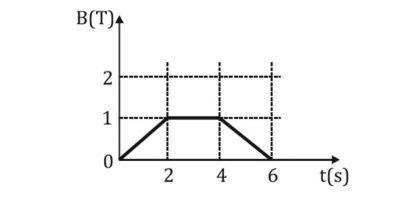
Q.28. An a.c. source generating a voltage ε = ε0 sin ωt is connected to a capacitor of capacitance C. Find the expression for the current I flowing through it. Plot a graph of ε and I versus t to show that the current is
ahead of the voltage by π/2.
OR
An ac voltage V = V0 sin t is applied across a pure inductor of inductance L. Find an expression for the current i, flowing in the circuit and show mathematically that the current flowing through it lags behind
the applied voltage by a phase angle of π/2. Also, draw graphs of V and i versus ωt for the circuit.
Q.29. Radiation of frequency 1015 Hz is incident on three photosensitive surfaces A, B, and C. The following observations are recorded:
Surface A: no photoemission occurs
Surface B: photoemission occurs but the photoelectrons have zero kinetic energy.
Surface C: photo emission occurs and photoelectrons have some kinetic energy.
Using Einstein’s photo-electric equation, explain the three observations.
OR
The graph shows the variation of photocurrent for a photosensitive metal
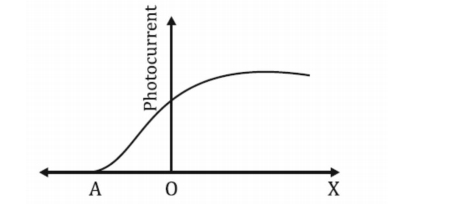
(a)What do X and A on the horizontal axis represent?
(b)Draw this graph for three different values of frequencies of incident radiation ʋ1, ʋ 2, and ʋ 3 (ʋ 3>ʋ 2>ʋ1) for the same intensity.
(c) Draw this graph for three different values of intensities of incident radiation I1, I2, and I3 (I3> I2>I1) having the same frequency.
Q.30. The ground state energy of the hydrogen atoms is -13.6 eV. The photon emitted during the transition of an electron from n=3 to n=1 state, is incident on a photosensitive material of unknown work function. The photoelectrons are emitted from the material with the maximum kinetic energy of 9eV. Calculate the threshold wavelength of the material used.
Class 12 Physics Sample Paper 2022-23: SECTION – D
SECTION D (5 marks each)
Q.31. (a)Draw equipotential surfaces for (i)an electric dipole and (ii) two identical positive charges placed near each other.
(b) In a parallel plate capacitor with air between the plates, each plate has an area of 6 x 10-³m², and the separation between the plates is 3 mm.
(i) Calculate the capacitance of the capacitor.
(ii) If the capacitor is connected to a 100V supply, what would be the charge on each plate?
(iii) How would the charge on the plate be affected if a 3 mm thick mica sheet of k=6 is inserted between the plates while the voltage supply remains connected?
OR
(a)Three charges –q, Q, and –q are placed at equal distances on a straight line. If the potential energy of the system of these charges is zero, then what is the ratio Q:q?
(b)(i) Obtain the expression for the electric field intensity due to a uniformly charged spherical shell of radius R at a point distant r from the center of the shell outside it.
(ii) Draw a graph showing the variation of electric field intensity E with r, for r > R and r < R.
Q.32.(a) Explain the term drift velocity of electrons in a conductor. Hence obtain the expression for the current through a conductor in terms of drift velocity.
(b) Two cells of EMFs E1 and E2 and internal resistances 𝑟¹and 𝑟² respectively are connected in parallel as shown in the figure. Deduce the expression for the
(i) equivalent emf of the combination
(ii) equivalent internal resistance of the combination
(iii) potential difference between points A and B.
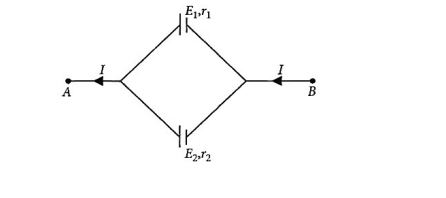 OR
OR
(a) State the two Kirchhoff’s rules used in the analysis of electric circuits and explain them.
(b) Derive the equation of the balanced state in a Wheatstone bridge using Kirchhoff’s laws.
Q.33. a) Draw the graph showing the intensity distribution of fringes with phase angle due to diffraction through a single slit. What is the width of the central maximum in comparison to that of a secondary maximum?
b) A ray PQ is incident normally on the face AB of a triangular prism of refracting angle 600 as shown in the figure.
The prism is made of a transparent material of a refractive index 2/√3. Trace the path of the ray as it passes through the prism. Calculate the angle of emergence and the angle of deviation.
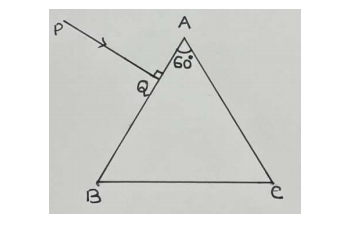
OR
a) Write two points of difference between an interference pattern and a diffraction pattern.
b) (i) A ray of light incident on face AB of an equilateral glass prism, shows the minimum deviation of 30°. Calculate the speed of light through the prism.
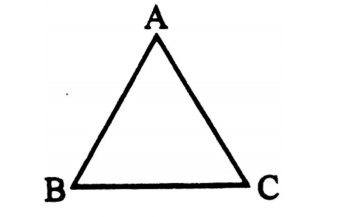
Q.34. Case Study :
Read the following paragraph and answer the questions.
A number of optical devices and instruments have been designed and developed such as periscope, binoculars,
microscopes and telescopes utilising the reflecting and refracting properties of mirrors, lenses and prisms. Most of them are in common use. Our knowledge about the formation of images by the mirrors and lenses is the basic requirement for understanding the working of these devices.
(i) Why the image formed at infinity is often considered most suitable for viewing. Explain
(ii) In modern microscopes multicomponent lenses are used for both the objective and the eyepiece. Why?
(iii) Write two points of difference between a compound microscope and an astronomical telescope
OR
(iii) Write two distinct advantages of a reflecting type telescope over a refracting type telescope.
Q.35. Case study: Light emitting diode.
Read the following paragraph and answer the questions
LED is a heavily doped P-N junction that under forwarding bias emits spontaneous radiation. When it is forward-biased, due to the recombination of holes and electrons at the junction, energy is released in the form of
photons. In the case of Si and Ge diodes, the energy released in recombination lies in the infrared region. LEDs that can emit red, yellow, orange, green, and blue light are commercially available. The semiconductor used for the fabrication of visible LEDs must at least have a band gap of 1.8 eV. The compound semiconductor Gallium Arsenide –Phosphide is used for making LEDs of different colors.
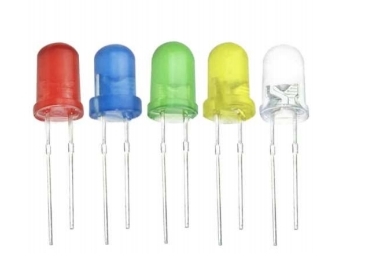
LEDs of different kinds
(i). Why are LEDs made of compound semiconductor and not of elemental semiconductors?
(ii) What should be the order of the bandgap of an LED, if it is required to emit light in the visible range?
(iii) A student connects the blue-colored
LED as shown in the figure. The LED did not glow when switch S is closed. Explain why?
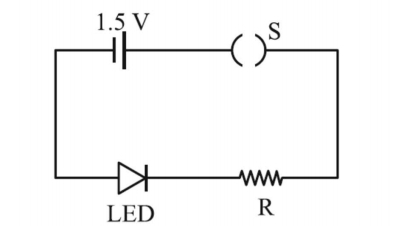
OR
(iii) Draw V-I characteristic of a p-n junction diode in (i) forward bias and (ii) reverse bias
Class 12 Physics Sample Question Paper 2023 Pdf
We have shared the Class 12 Physics Sample Question Paper 2023 Pdf to help the students with the sample paper so that they can download it from the below link and practice it to boost their preparation.
https://drive.google.com/file/d/1RQtoZXDfTGVt7rF2I9s0zajzyqMij5B7/view?usp=sharing
Class 12 Physics Sample Question Paper 2023 Marking Scheme
We have shared the Class 12 Physics Sample Question Paper 2023 Marking Scheme to help the students with the sample paper so that they can download it from the below link and practice it to boost their preparation.
https://drive.google.com/file/d/1RW_V-8Hkw8QsDjNuwEdJ5N4vaREuzOkF/view?usp=sharing
Conclusion
We have covered the CBSE Class 12 Physics Sample Paper 2023. The students must solve CBSE Class 12 Physics Sample Paper which is given on this page and bookmark this page to get all the latest updates from CBSE regarding CBSE Annual Exam.
Related Articles
